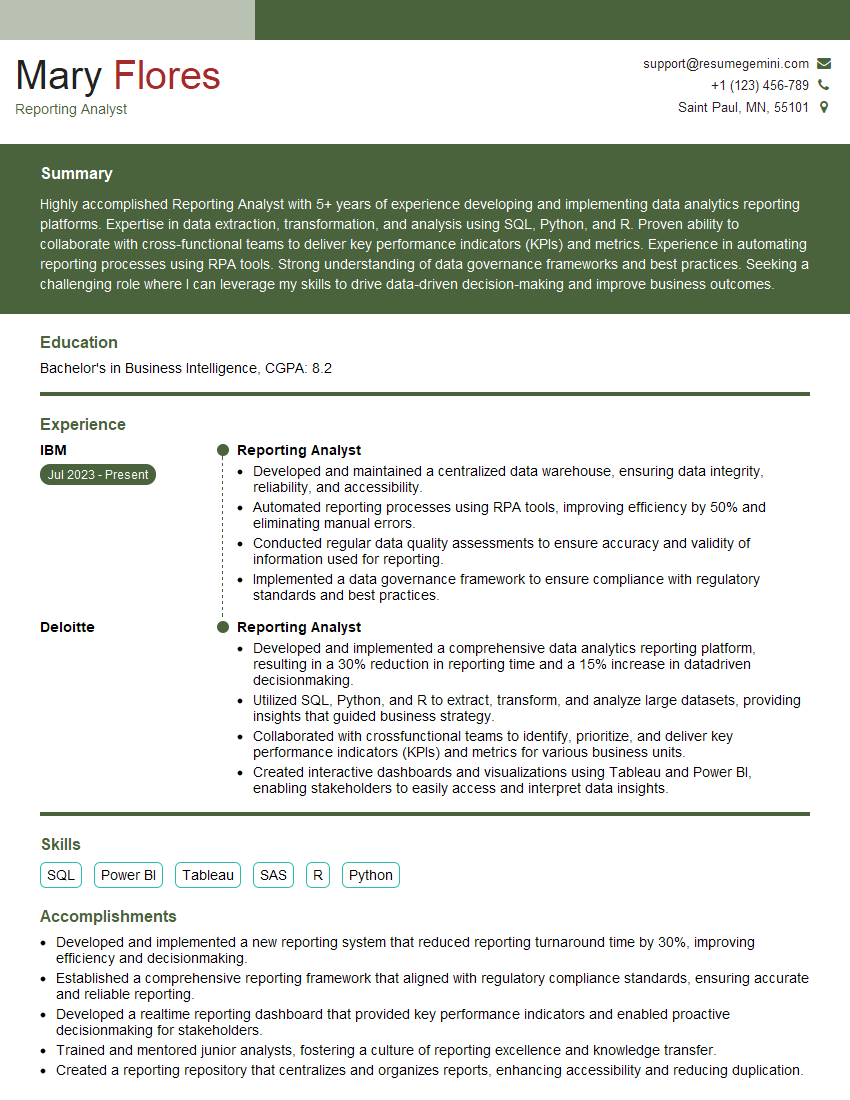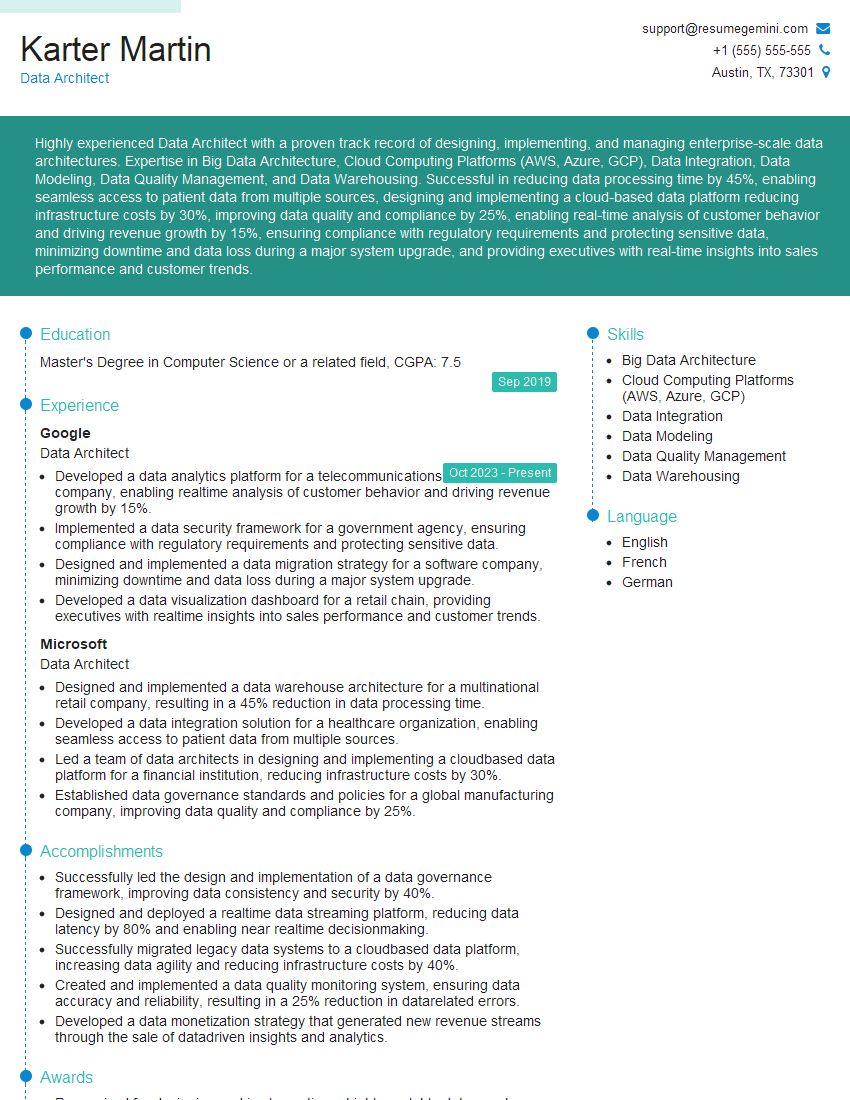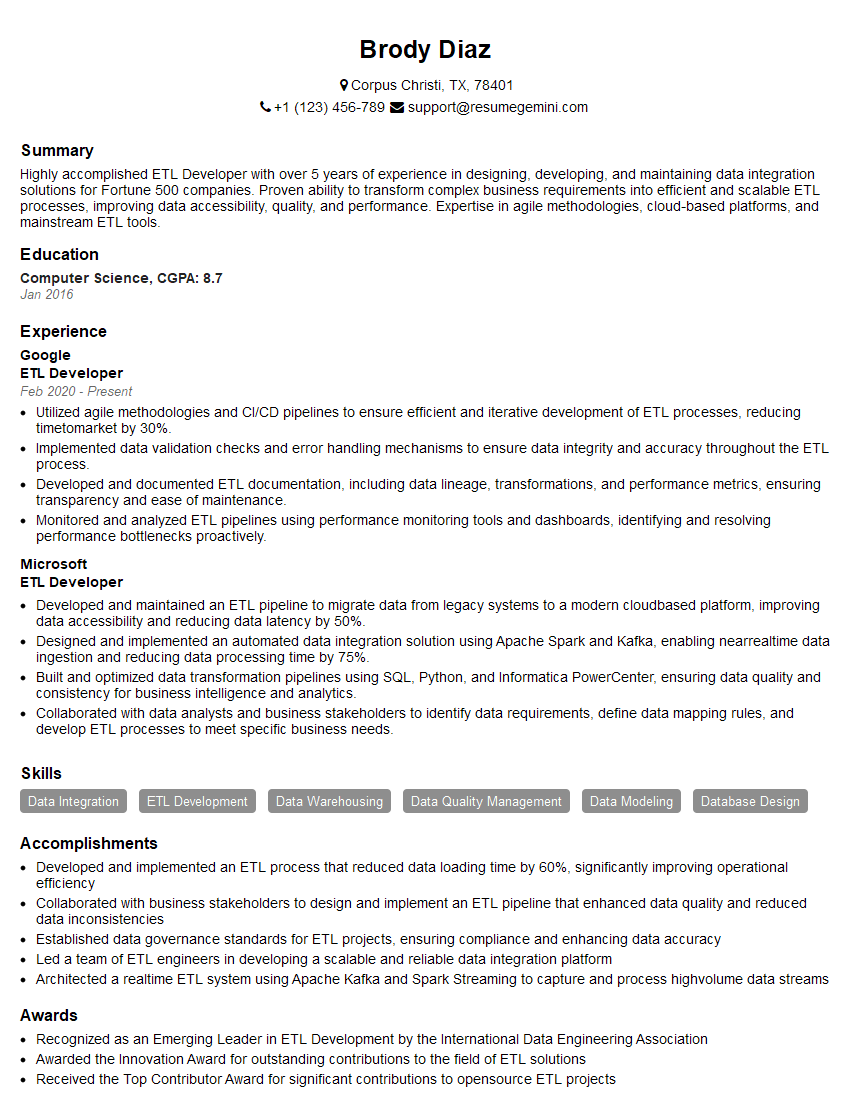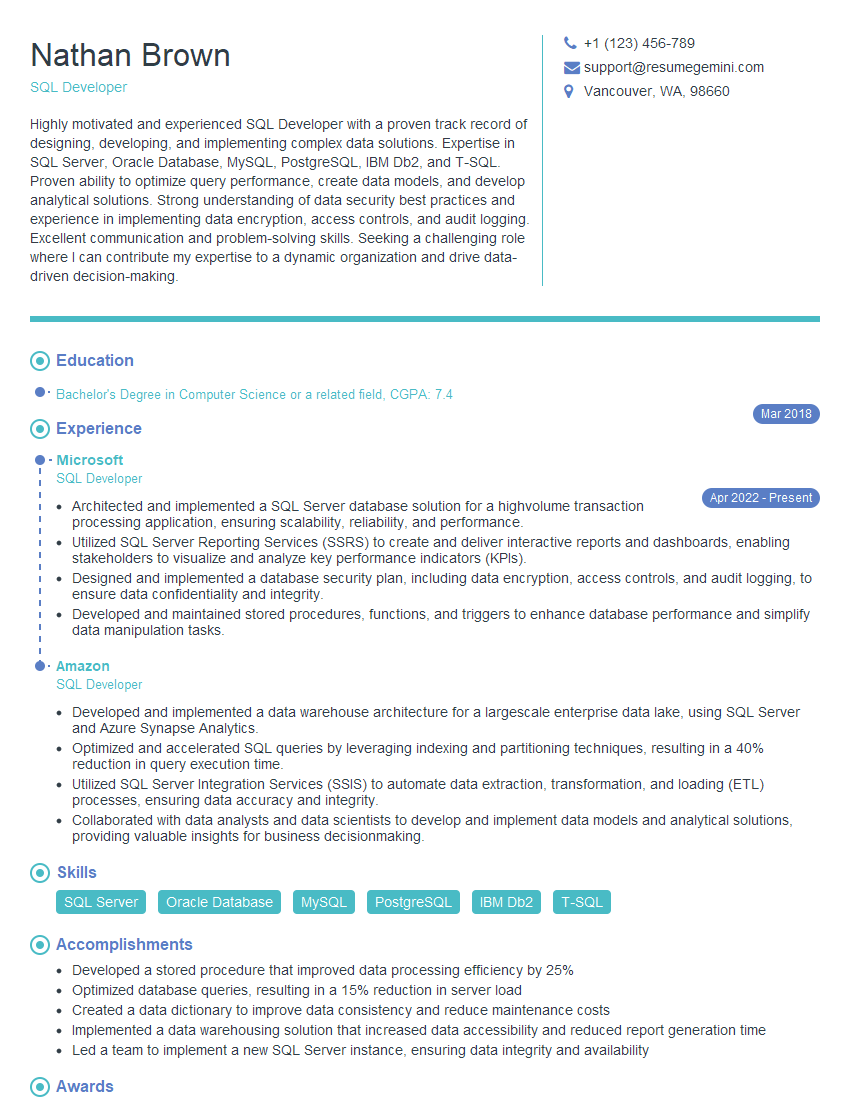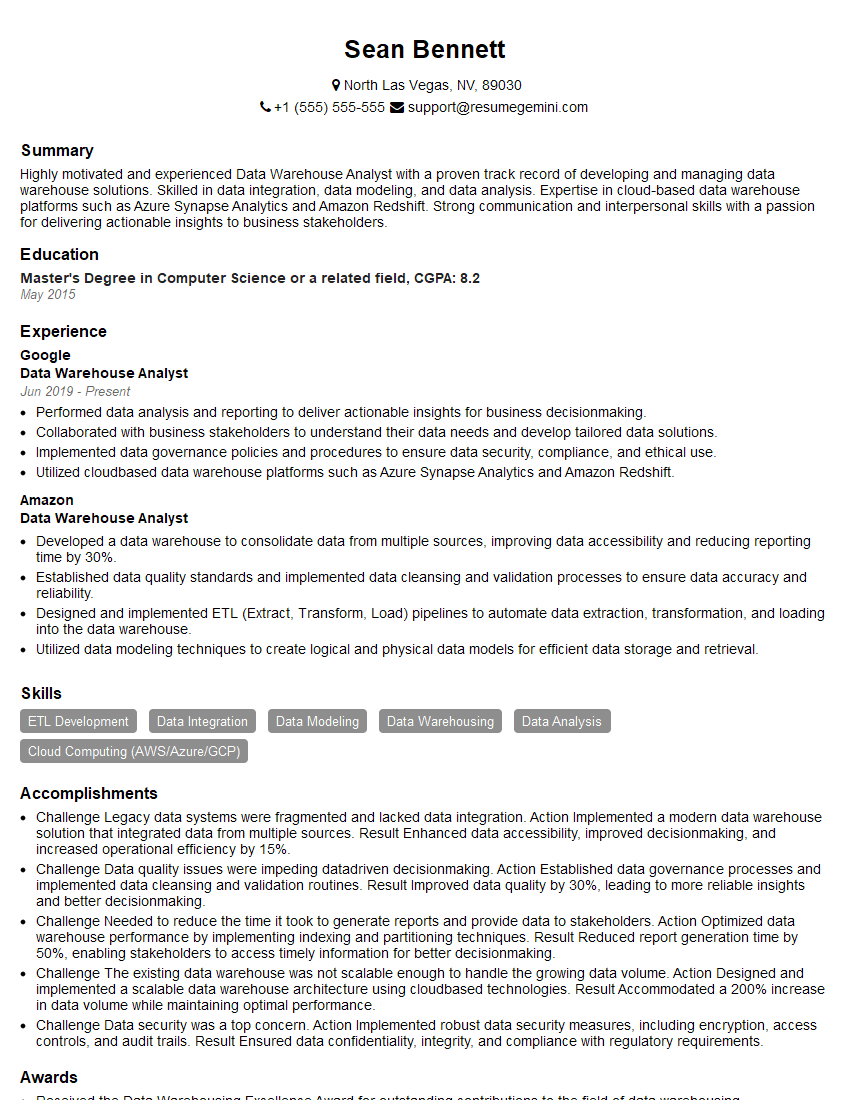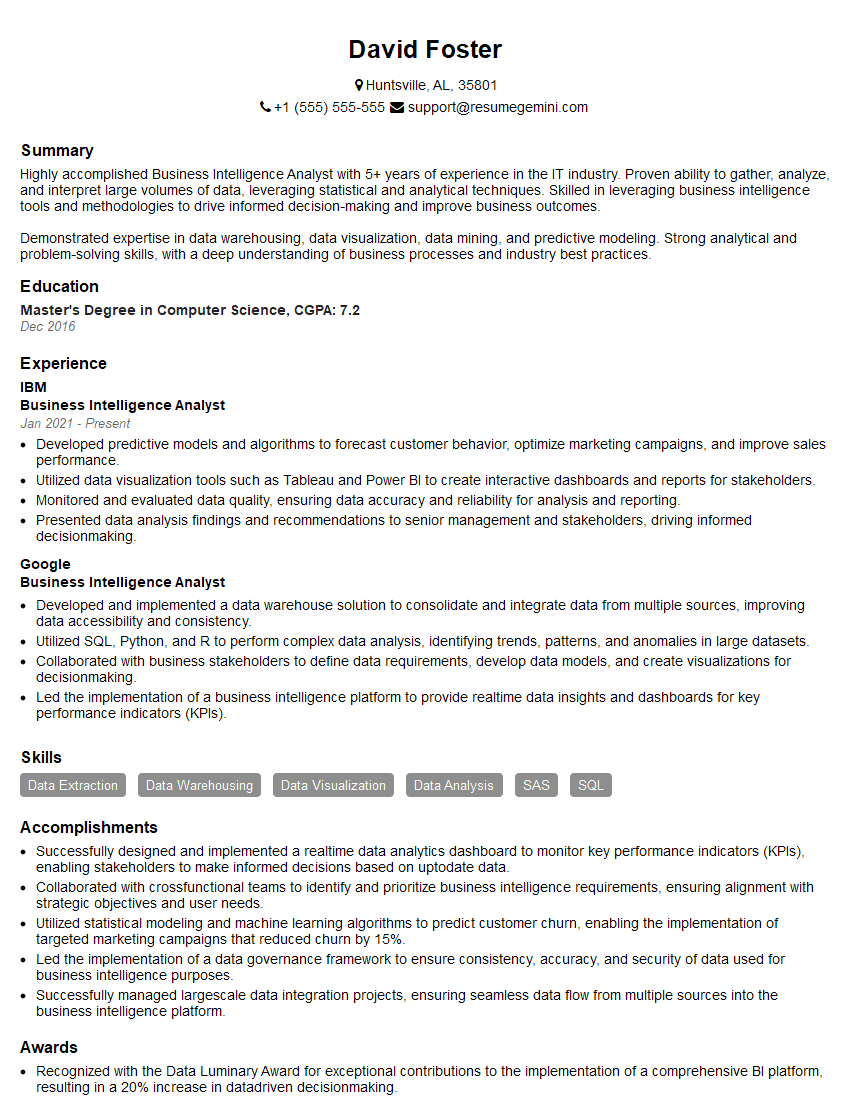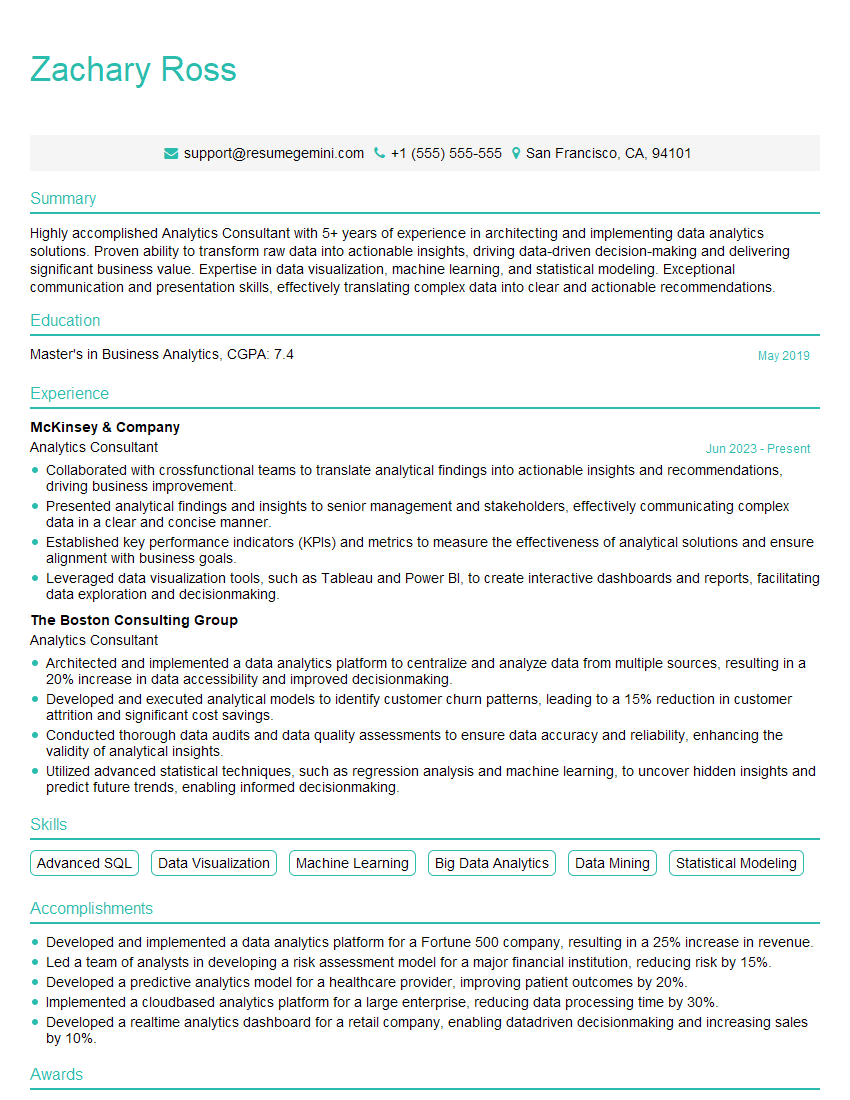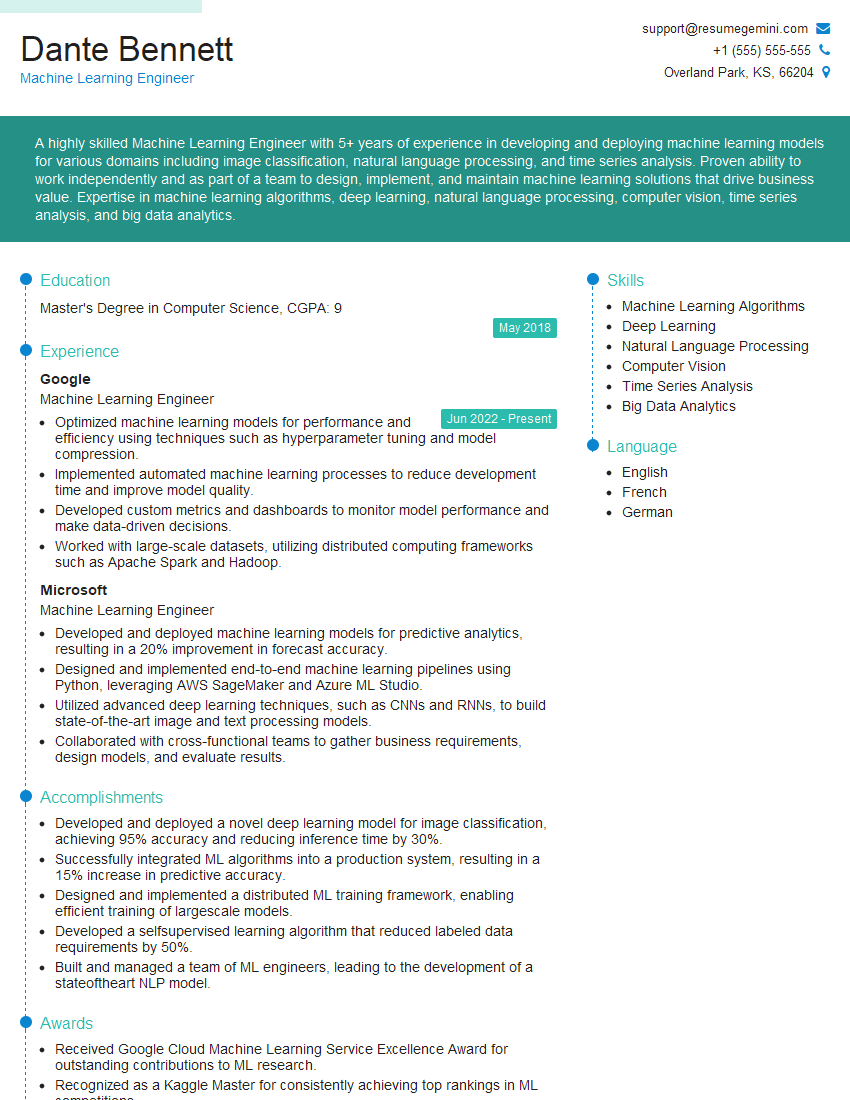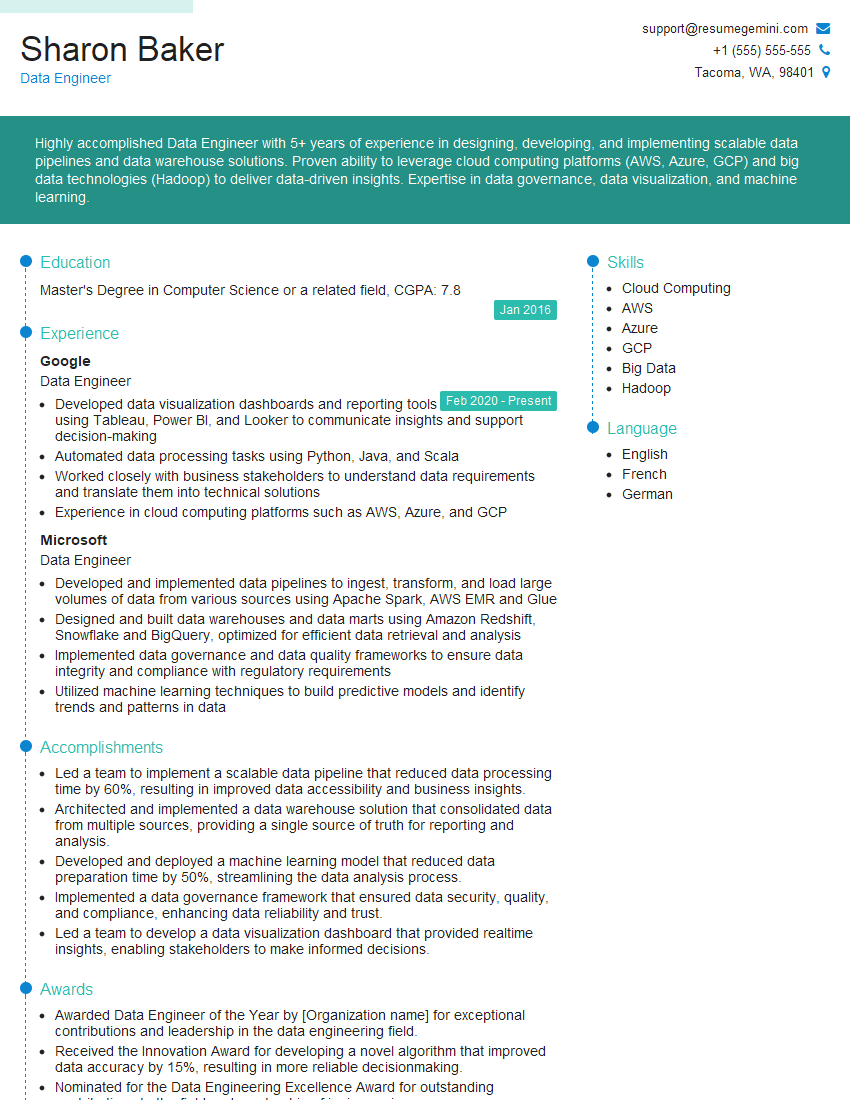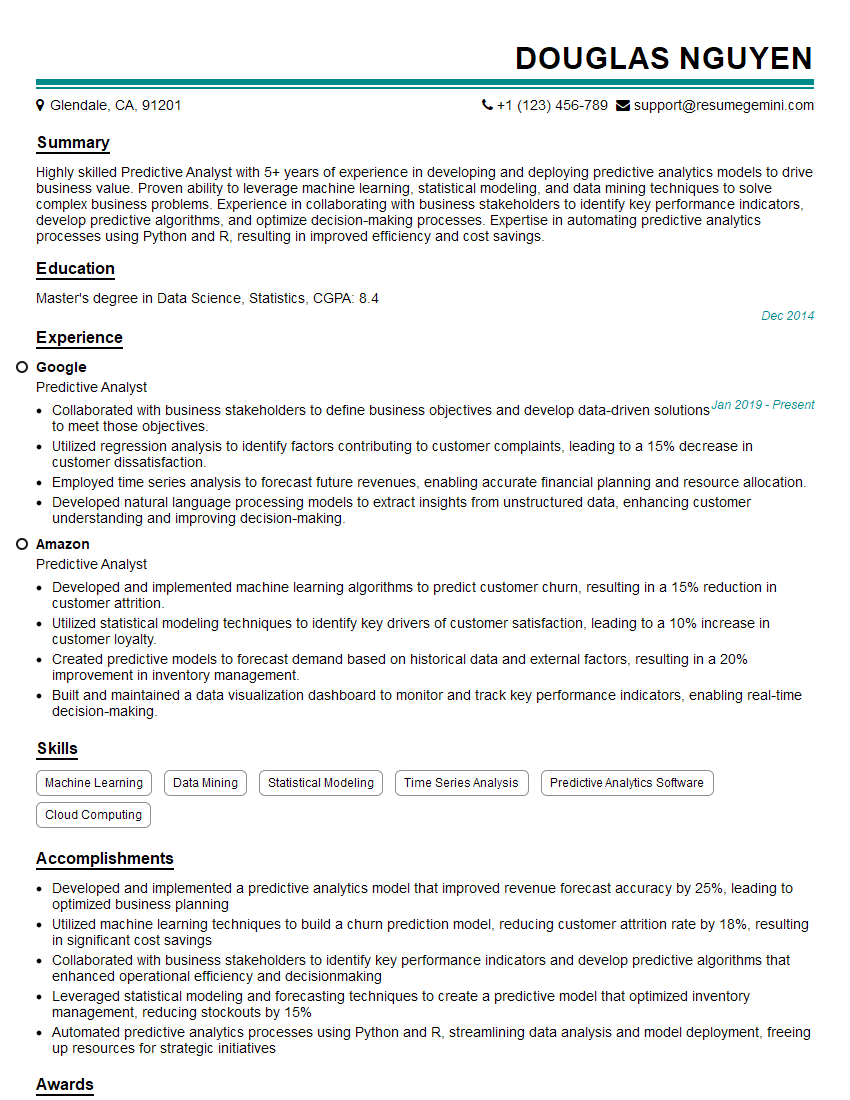Feeling uncertain about what to expect in your upcoming interview? We’ve got you covered! This blog highlights the most important Data Analysis (SQL, Python) interview questions and provides actionable advice to help you stand out as the ideal candidate. Let’s pave the way for your success.
Questions Asked in Data Analysis (SQL, Python) Interview
Q 1. Explain the difference between INNER JOIN and LEFT JOIN in SQL.
Both INNER JOIN and LEFT JOIN are used to combine rows from two or more tables based on a related column between them. The key difference lies in which rows are included in the result set.
An INNER JOIN returns only the rows where the join condition is met in both tables. Think of it like finding the intersection of two sets. If a row in one table doesn’t have a matching row in the other based on the join condition, it’s excluded from the result.
A LEFT JOIN, on the other hand, returns all rows from the left table (the table specified before LEFT JOIN), even if there is no match in the right table. For rows in the left table that do have a match in the right table, the corresponding columns from the right table are included. If there’s no match, the columns from the right table will show as NULL. It’s like taking everything from the left set and including matching elements from the right set; unmatched elements from the left set are kept, but unmatched from the right are shown as empty.
Example: Let’s say we have two tables: Customers (CustomerID, Name) and Orders (OrderID, CustomerID, Amount).
INNER JOINwould only show customers who have placed orders.LEFT JOINwould show all customers, including those who haven’t placed any orders (their order information would beNULL).
Imagine you’re analyzing sales data. An INNER JOIN is useful if you only want to analyze customers who have made purchases. A LEFT JOIN is more suitable if you need to see all customers, even those who haven’t made any purchases, to identify potential opportunities or inactive accounts.
Q 2. Write a SQL query to find the top 5 customers with the highest total purchase amount.
To find the top 5 customers with the highest total purchase amount, we need to aggregate order data by customer and then order the results. Assuming your tables are structured as in the previous example, here’s the SQL query:
SELECT c.Name, SUM(o.Amount) AS TotalPurchaseAmount
FROM Customers c
INNER JOIN Orders o ON c.CustomerID = o.CustomerID
GROUP BY c.Name
ORDER BY TotalPurchaseAmount DESC
LIMIT 5;This query first joins the Customers and Orders tables using an INNER JOIN to link customers to their orders. Then, it uses SUM(o.Amount) to calculate the total purchase amount for each customer, grouping the results by customer name using GROUP BY c.Name. Finally, it orders the results in descending order of TotalPurchaseAmount and limits the output to the top 5 using LIMIT 5. This gives you a clear, concise list of your top-spending clients.
Q 3. How would you handle missing values in a dataset using Python?
Handling missing values, or NaN (Not a Number) values, is crucial for accurate data analysis. In Python, several methods exist, each with its strengths and weaknesses depending on the context and data characteristics.
- Deletion: Removing rows or columns with missing values is the simplest approach. However, this can lead to significant information loss if many values are missing. Use this cautiously, and only when the missing data is a small percentage and random.
- Imputation: Replacing missing values with estimated values is a better approach than deletion in most cases. Common imputation techniques include:
- Mean/Median/Mode Imputation: Replacing missing values with the mean (average), median (middle value), or mode (most frequent value) of the respective column. Simple, but can distort the distribution if there are many missing values.
- K-Nearest Neighbors (KNN) Imputation: Predicting missing values based on the values of similar data points. More sophisticated, but computationally intensive.
- Multiple Imputation: Creating multiple plausible imputed datasets and combining the results. Handles uncertainty better than single imputation methods.
The pandas library in Python provides excellent tools for handling missing data. For example, using fillna() to impute values:
import pandas as pd
data = {'A': [1, 2, None, 4], 'B': [5, None, 7, 8]}
df = pd.DataFrame(data)
df.fillna(df.mean(), inplace=True) #Imputes using column meansChoosing the right method depends on the dataset, the percentage of missing values, and the goals of the analysis. Always carefully consider the implications of each technique.
Q 4. Explain different methods for data cleaning in Python.
Data cleaning in Python is a critical step to ensure data quality and reliability before analysis. It involves various techniques to handle inconsistencies, errors, and redundancies.
- Handling Missing Values: As discussed earlier, techniques like imputation or deletion can handle missing data. The choice depends on the context and the amount of missing data.
- Removing Duplicates: Duplicate rows can skew results. Pandas’
duplicated()anddrop_duplicates()functions are helpful to identify and remove duplicates. - Data Transformation: This involves converting data into a suitable format for analysis. It may include:
- Data Type Conversion: Changing data types (e.g., string to numeric).
- Standardization/Normalization: Scaling features to a similar range.
- Binning: Grouping continuous data into discrete bins.
- Outlier Detection and Treatment: Outliers are extreme values that might be errors or genuine anomalies. Methods like box plots, IQR (Interquartile Range), or Z-score can detect outliers. Treatment involves removing or transforming them (e.g., capping, winsorizing).
- Data Consistency Checks: Ensure consistency in data representation (e.g., consistent date formats, units of measurement).
- Error Correction: Fixing incorrect values based on domain knowledge or data validation rules.
Remember to document all cleaning steps meticulously. This helps reproducibility and aids others in understanding your data transformations.
Q 5. What are the common data structures used in Python for data analysis?
Python offers several powerful data structures ideal for data analysis. The most commonly used are:
- Lists: Ordered, mutable (changeable) collections of items. Good for general-purpose tasks but less efficient for large datasets than other structures.
- Dictionaries: Unordered collections of key-value pairs. Excellent for representing structured data where you need to access elements by name (key).
- Tuples: Ordered, immutable (unchangeable) collections of items. Useful for representing records or fixed data structures where modifications are not needed.
- Sets: Unordered collections of unique items. Useful for removing duplicates or performing set operations (union, intersection).
- NumPy Arrays: Highly efficient multidimensional arrays for numerical data. Form the backbone of many scientific and numerical computations in Python. NumPy’s optimized functions make calculations much faster than with standard Python lists.
- Pandas Series and DataFrames: Built on top of NumPy, these provide powerful tools for data manipulation and analysis. Series are one-dimensional labeled arrays, and DataFrames are two-dimensional labeled data structures (like tables in a spreadsheet).
The choice of data structure depends on the specific analysis task and the nature of your data. Pandas DataFrames are particularly popular due to their ease of use and versatility in data analysis.
Q 6. Explain the concept of normalization in databases.
Database normalization is a systematic process of organizing data to reduce redundancy and improve data integrity. It involves dividing larger tables into smaller tables and defining relationships between them. This ensures that data is stored logically and efficiently.
The main goals of normalization are:
- Minimize data redundancy: Reducing duplicate data saves storage space and ensures data consistency.
- Improve data integrity: Reduces inconsistencies and errors by eliminating redundant data.
- Simplify data modification: Changes to data need to be made in only one place, simplifying maintenance and updates.
Normalization is achieved through different normal forms, such as:
- First Normal Form (1NF): Eliminate repeating groups of data within a table. Each column should contain atomic values (indivisible values).
- Second Normal Form (2NF): Be in 1NF and eliminate redundant data that depends on only part of the primary key (in tables with composite keys).
- Third Normal Form (3NF): Be in 2NF and eliminate data that is not dependent on the primary key (transitive dependency).
Choosing the appropriate normal form depends on the specific application and the trade-offs between data redundancy and query performance. Over-normalization can sometimes lead to complex queries, so finding the right balance is essential.
Q 7. What are the advantages of using Python for data analysis?
Python has become a dominant language in data analysis due to several advantages:
- Rich Ecosystem of Libraries: Python boasts a vast collection of libraries specifically designed for data analysis, such as Pandas, NumPy, Scikit-learn, Matplotlib, and Seaborn. These libraries offer efficient tools for data manipulation, cleaning, visualization, and machine learning.
- Ease of Use and Readability: Python’s syntax is clear and concise, making it easier to learn and use compared to some other languages. This makes it accessible to both experienced programmers and those new to data analysis.
- Large and Active Community: A massive community provides abundant support, resources, and readily available solutions to common problems. Finding help and tutorials is straightforward.
- Versatility: Python is not limited to data analysis. It’s used extensively in web development, scripting, and automation, making it a valuable skill in diverse roles.
- Open Source and Free: Python is free to use and distribute, making it accessible to everyone.
- Integration with other tools: Python seamlessly integrates with various database systems, cloud platforms, and other analytical tools.
In short, Python’s combination of ease of use, powerful libraries, and a supportive community has made it a preferred choice for data scientists and analysts worldwide.
Q 8. Describe your experience with data visualization libraries in Python (e.g., Matplotlib, Seaborn).
Matplotlib and Seaborn are powerful Python libraries for data visualization. Matplotlib is the foundational library, offering a wide range of plotting capabilities, from basic line plots and scatter plots to complex histograms and 3D visualizations. It provides fine-grained control over every aspect of the plot, which is great for customization but can be more verbose. Seaborn, built on top of Matplotlib, simplifies the process by providing a higher-level interface with statistically informative plots. It excels at creating visually appealing and insightful visualizations with less code.
In my experience, I frequently use Matplotlib for creating highly customized plots when precise control is necessary, such as when generating publication-quality figures or intricate diagrams. Seaborn, however, is my go-to for rapid prototyping and exploratory data analysis, allowing me to quickly generate informative visualizations like box plots, violin plots, and heatmaps which offer insightful summaries of data distributions and relationships. For instance, I recently used Seaborn’s pairplot function to quickly visualize the correlations between various features of a customer dataset, which significantly sped up the initial exploratory phase of my analysis.
Here’s a simple example illustrating the difference:
import matplotlib.pyplot as plt
import seaborn as sns
import numpy as np
# Matplotlib example
x = np.linspace(0, 10, 100)
y = np.sin(x)
plt.plot(x, y)
plt.xlabel('X-axis')
plt.ylabel('Y-axis')
plt.title('Simple Sine Wave')
plt.show()
# Seaborn example
data = {'x': np.random.rand(100), 'y': np.random.rand(100)}
df = pd.DataFrame(data)
sns.scatterplot(x='x', y='y', data=df)
plt.show()Q 9. How do you optimize SQL queries for performance?
Optimizing SQL queries for performance involves several key strategies. The core idea is to minimize the amount of data the database needs to process. This often involves choosing the right indexes, writing efficient queries, and understanding the execution plan.
- Use appropriate indexes: Indexes are like the index of a book – they allow the database to quickly locate specific rows without scanning the entire table. Different indexes serve different purposes (covered in detail in a later question). Careful consideration of which columns to index is crucial.
- Write efficient queries: Avoid using wildcard characters (%) at the beginning of
LIKEclauses (e.g.,WHERE name LIKE '%john%'is less efficient thanWHERE name LIKE 'john%'). UseEXISTSinstead ofCOUNT(*)subqueries when checking for existence. Minimize the use of functions and calculations inWHEREclauses. - Filter early: Apply filters as early as possible in the query to reduce the amount of data that needs to be processed in subsequent steps. This might involve optimizing the
JOINorder. - Use appropriate data types: Using smaller data types can reduce storage space and improve query performance. Using the correct data type for the column is very crucial.
- Analyze the query execution plan: Most database systems provide tools to visualize the execution plan. This helps identify bottlenecks and optimize the query execution.
For example, consider a query to find users in a specific city. Without an index on the city column, the database would have to scan the entire user table. With an index, it can directly jump to the relevant rows, resulting in significant performance gains.
Q 10. What are common SQL performance issues and how to fix them?
Common SQL performance issues often stem from poorly written queries or a lack of proper indexing. Here are a few common issues and their fixes:
- Full table scans: This happens when the database has to read every row of a table to satisfy a query, which is incredibly slow for large tables. Fix: Create appropriate indexes on the columns used in
WHEREclauses. - Inefficient joins: Poorly designed joins, such as joining very large tables without proper indexes, can lead to performance bottlenecks. Fix: Use appropriate
JOINtypes (INNER JOIN,LEFT JOIN, etc.) and create indexes on join columns. - Lack of indexing: The absence of indexes on frequently queried columns dramatically slows down data retrieval. Fix: Identify frequently accessed columns and create appropriate indexes.
- Suboptimal query structure: Poorly structured queries can lead to unnecessary computations and data processing. Fix: Rewrite the query to minimize redundant operations and filter data early. Analyze the query plan to identify areas for improvement.
- Missing statistics: Database optimizers rely on table statistics to make informed decisions about query execution. Outdated or missing statistics can lead to inefficient query plans. Fix: Regularly update table statistics to ensure the optimizer has accurate information.
I once encountered a performance issue in a production database where a simple query was taking several minutes to run. After analyzing the query execution plan, I discovered it was performing a full table scan on a large table. Adding an index to the relevant column reduced the query execution time to milliseconds.
Q 11. Explain different types of database indexes and their uses.
Database indexes are data structures that improve the speed of data retrieval operations on a database table at the cost of additional writes and storage space to maintain the index data structure. Several types of indexes exist, each with its strengths and weaknesses:
- B-tree index: This is the most common type of index, suitable for both equality and range queries. It’s efficient for searching, sorting, and retrieving data based on a key. Many database systems use variations of B-trees for performance optimization.
- Hash index: Hash indexes are very efficient for equality searches, offering faster lookups than B-tree indexes in those cases. However, they are not suitable for range queries or sorting.
- Full-text index: These indexes are designed to efficiently search for text within a column. They are often used for finding keywords or phrases within large amounts of textual data.
- Spatial index: Used for data with geographic coordinates (latitude and longitude), spatial indexes are optimized for queries involving proximity or spatial relationships.
- Unique index: Enforces uniqueness within a column or set of columns, preventing duplicate entries. Often used for primary keys.
Choosing the right index is crucial. For example, a B-tree index is ideal for frequently querying data based on a specific range of values (e.g. finding all users between the age of 25 and 35), while a hash index would be better if you only needed to retrieve a specific user based on their unique user ID.
Q 12. How do you handle large datasets in Python?
Handling large datasets in Python efficiently requires strategies that avoid loading the entire dataset into memory at once. This commonly involves using libraries designed for this purpose, and techniques for efficient data processing:
- Dask: Dask provides parallel computing capabilities, allowing you to process large datasets that don’t fit in memory by dividing them into smaller chunks and processing them concurrently. It works seamlessly with Pandas and NumPy.
- Vaex: Vaex is another excellent library for out-of-core computation. It allows for lazy evaluations and memory mapping, meaning data is processed only when needed and is not loaded entirely in memory. It offers efficient operations on tabular data, like Pandas, but with a focus on scalability.
- Pandas with chunksize: When reading data from files (like CSV or Parquet), Pandas allows using the
chunksizeparameter in theread_csvorread_parquetfunction. This reads the file in smaller chunks, processing each chunk individually. This allows for iterative processing of large files without memory exhaustion. - Data Generators: Instead of loading the entire dataset, consider using data generators, which load data on demand as needed. This is extremely useful for deep learning models, for example, where the entire dataset is too large to fit in memory but you can process batches.
For example, to read a large CSV file in chunks using Pandas:
import pandas as pd
chunksize = 10000 # Adjust this based on your memory capacity
for chunk in pd.read_csv('large_file.csv', chunksize=chunksize):
# Process each chunk individually
# ...your analysis code here...
print(f'Processed chunk with {len(chunk)} rows')Q 13. What is the difference between Pandas and NumPy?
NumPy and Pandas are both fundamental Python libraries for data manipulation, but they serve different purposes and have distinct strengths:
- NumPy (Numerical Python): NumPy is focused on numerical computation and provides the
ndarray(n-dimensional array) object, a powerful data structure for efficient numerical operations. It’s the foundation for many other scientific computing libraries in Python. NumPy is optimized for numerical calculations and excels at vectorized operations, meaning operations are applied to entire arrays at once, leading to significant speed improvements compared to element-wise operations in standard Python lists. NumPy doesn’t directly handle labeled data or data structures like tables. - Pandas: Pandas builds on NumPy and introduces the
DataFrameobject, a tabular data structure similar to spreadsheets or SQL tables. Pandas provides tools for data cleaning, transformation, analysis, and manipulation. It offers features for handling missing data, reshaping data, and working with time series data. Pandas is very versatile but can be less efficient for pure numerical calculations than NumPy for very large datasets.
In essence, NumPy provides the efficient numerical engine, while Pandas builds a user-friendly interface for data manipulation and analysis on top of it. They often work together. For example, NumPy’s arrays might be used for calculations within a Pandas DataFrame.
Q 14. Write a Python function to calculate the mean, median, and mode of a list of numbers.
Here’s a Python function to calculate the mean, median, and mode of a list of numbers:
import statistics
def calculate_stats(data):
"""Calculates the mean, median, and mode of a list of numbers.
Args:
data: A list of numbers.
Returns:
A dictionary containing the mean, median, and mode.
Returns an error message if the input is invalid.
"""
if not isinstance(data, list):
return "Error: Input must be a list."
if not all(isinstance(x, (int, float)) for x in data):
return "Error: List must contain only numbers."
if len(data) == 0:
return "Error: List cannot be empty."
mean = statistics.mean(data)
median = statistics.median(data)
try:
mode = statistics.mode(data)
except statistics.StatisticsError:
mode = "No unique mode"
return {"mean": mean, "median": median, "mode": mode}
# Example usage
my_data = [1, 2, 3, 3, 4, 5]
results = calculate_stats(my_data)
print(results) # Output: {'mean': 3, 'median': 3, 'mode': 3}
my_data2 = [1, 2, 3, 4, 5]
results2 = calculate_stats(my_data2)
print(results2) #Output: {'mean': 3, 'median': 3, 'mode': 'No unique mode'}Q 15. How would you perform data aggregation in SQL?
Data aggregation in SQL involves summarizing data from multiple rows into a single row. Think of it like condensing a large spreadsheet into a smaller one with key summary statistics. We use aggregate functions to achieve this.
- Common Aggregate Functions:
COUNT()(counts rows),SUM()(sums values),AVG()(calculates the average),MIN()(finds the minimum value),MAX()(finds the maximum value). GROUP BYClause: This is crucial for grouping rows before aggregation. For example, you might group sales data by product category to see the total sales for each category.
Example: Let’s say we have a table named sales with columns product_category and sales_amount. To find the total sales for each category, we’d use:
SELECT product_category, SUM(sales_amount) AS total_sales FROM sales GROUP BY product_category;This query groups the rows by product_category and then calculates the sum of sales_amount for each group, labeling the result as total_sales. The GROUP BY clause is essential; without it, you’d get a single sum for all sales.
In a real-world scenario, this could be used to analyze sales performance across different product lines, identify top-performing categories, or inform inventory management decisions.
Career Expert Tips:
- Ace those interviews! Prepare effectively by reviewing the Top 50 Most Common Interview Questions on ResumeGemini.
- Navigate your job search with confidence! Explore a wide range of Career Tips on ResumeGemini. Learn about common challenges and recommendations to overcome them.
- Craft the perfect resume! Master the Art of Resume Writing with ResumeGemini’s guide. Showcase your unique qualifications and achievements effectively.
- Don’t miss out on holiday savings! Build your dream resume with ResumeGemini’s ATS optimized templates.
Q 16. Explain the concept of ACID properties in databases.
ACID properties are a set of guarantees that ensure database transactions are processed reliably. Think of them as the four cornerstones of reliable data management. A transaction failing to meet even one of these properties is considered unreliable.
- Atomicity: The entire transaction is treated as a single, indivisible unit. Either all changes within the transaction are applied successfully, or none are. It’s an all-or-nothing approach, preventing partial updates that could corrupt data.
- Consistency: The transaction maintains the integrity of the database. It starts in a valid state, performs operations, and ends in another valid state. Rules and constraints are enforced to prevent inconsistent data from entering the database.
- Isolation: Concurrent transactions are isolated from each other. Changes made by one transaction are not visible to other transactions until the first transaction is committed. This prevents conflicts and ensures data accuracy.
- Durability: Once a transaction is committed, the changes are permanently stored and survive system failures (like power outages or crashes). This ensures data persistence.
Example: Imagine transferring money between two bank accounts. ACID properties ensure that either both accounts are updated correctly (debiting one and crediting the other) or neither is, preventing situations where money disappears or is duplicated.
Q 17. How would you handle outliers in a dataset?
Outliers are data points that significantly deviate from the rest of the data. They can skew analyses and lead to inaccurate conclusions. Handling them requires careful consideration.
- Detection: Methods include visual inspection (scatter plots, box plots), statistical measures like Z-scores (measuring how many standard deviations a point is from the mean) or the Interquartile Range (IQR) method (identifying points outside a specified range).
- Handling: The best approach depends on the context. Options include:
- Removal: Removing outliers is suitable if they are clearly errors or are due to exceptional circumstances that don’t represent the general trend. However, be cautious; removing too many data points can lead to bias.
- Transformation: Transforming data (e.g., using logarithmic transformations) can sometimes reduce the impact of outliers.
- Winsorizing/Trimming: Replacing outliers with less extreme values (Winsorizing) or removing a certain percentage of extreme values from both ends of the data (Trimming).
- Robust Statistical Methods: Using statistical methods less sensitive to outliers, such as median instead of mean, or robust regression techniques.
Example: In analyzing house prices, a mansion worth significantly more than other houses in the dataset would be an outlier. Simply removing it might be appropriate if it’s clear this is an exceptional case not representative of the typical housing market. Alternatively, using median price instead of average price might be a better robust statistic.
Q 18. What are some common data analysis techniques?
Common data analysis techniques are many and varied, and often used in combination. Here are a few key examples:
- Descriptive Statistics: Summarizing data using measures like mean, median, mode, standard deviation, etc. This gives a basic understanding of the data’s distribution.
- Exploratory Data Analysis (EDA): Using visualizations and summary statistics to uncover patterns, relationships, and anomalies in data. This is crucial for hypothesis generation.
- Regression Analysis: Modeling the relationship between a dependent variable and one or more independent variables. This allows for prediction and understanding of causal relationships (with caution).
- Classification: Categorizing data into predefined classes. Techniques include logistic regression, decision trees, and support vector machines.
- Clustering: Grouping similar data points together without predefined classes. K-means and hierarchical clustering are common algorithms.
- Time Series Analysis: Analyzing data points collected over time to identify trends, seasonality, and forecasting future values.
The choice of technique depends entirely on the research question and the nature of the data.
Q 19. Describe your experience with data warehousing concepts.
Data warehousing involves designing and building a central repository of integrated data from various sources. Think of it as a single source of truth for business intelligence and reporting. My experience encompasses:
- Data Modeling: Designing dimensional models (star schema, snowflake schema) to organize data for efficient querying and analysis. This involves understanding business requirements and translating them into a logical data structure.
- ETL (Extract, Transform, Load) Processes: Building and maintaining pipelines that extract data from various sources, transform it into a consistent format, and load it into the data warehouse. This often involves dealing with data inconsistencies and cleaning/transforming raw data.
- Data Warehousing Technologies: Experience with various database systems (like Snowflake, Redshift, BigQuery) optimized for data warehousing, understanding their capabilities and limitations.
- Performance Tuning: Optimizing query performance and data loading efficiency to ensure fast and responsive reporting.
In a past project, I designed and implemented a data warehouse for a large e-commerce company, integrating data from sales transactions, customer databases, and marketing campaigns. This enabled them to gain valuable insights into customer behavior and sales trends, ultimately improving their business decisions.
Q 20. Explain your approach to solving a data analysis problem.
My approach to solving a data analysis problem is systematic and iterative:
- Understanding the Problem: Clearly defining the business problem and objectives. What questions are we trying to answer? What insights are we aiming to gain?
- Data Acquisition and Exploration: Gathering the necessary data from various sources and performing EDA to understand its structure, quality, and potential issues.
- Data Cleaning and Preprocessing: Handling missing values, outliers, and inconsistencies in the data to ensure its accuracy and reliability. This step is often iterative.
- Feature Engineering: Creating new variables or features from existing ones to improve the predictive power or interpretability of models.
- Model Selection and Training: Choosing appropriate analytical techniques (regression, classification, clustering, etc.) and training models based on the problem and data characteristics.
- Model Evaluation and Refinement: Assessing model performance using appropriate metrics and iteratively refining the model to improve its accuracy and generalizability.
- Communication of Results: Communicating findings clearly and concisely to stakeholders using visualizations and plain language, emphasizing actionable insights.
Throughout this process, I emphasize collaboration and iterative refinement, ensuring the analysis is rigorous and the results are meaningful and relevant to the business problem.
Q 21. How do you ensure data quality and accuracy?
Ensuring data quality and accuracy is paramount. My approach involves several key steps:
- Data Validation: Implementing checks and validation rules during data ingestion to identify and reject invalid or inconsistent data. This includes data type checks, range checks, and uniqueness checks.
- Data Cleansing: Identifying and correcting errors, inconsistencies, and missing values in the data. This often involves using automated scripts and manual review.
- Data Profiling: Analyzing data characteristics (data types, distributions, missing values, etc.) to identify potential quality issues and inform data cleansing strategies.
- Source Control and Versioning: Tracking changes to data and code using version control systems (like Git) to ensure reproducibility and traceability.
- Documentation: Maintaining clear and concise documentation of data sources, cleaning procedures, and analytical methods.
- Regular Monitoring: Continuously monitoring data quality metrics and implementing alerts to identify and address any emerging issues.
For example, I might implement automated checks to ensure that customer IDs are unique, dates are valid, and numerical values are within a reasonable range. Continuous monitoring of key metrics provides early warning of potential data quality problems.
Q 22. What is your experience with ETL processes?
ETL, or Extract, Transform, Load, is the process of collecting data from various sources, cleaning and transforming it, and loading it into a target data warehouse or database. My experience encompasses the entire ETL lifecycle. I’ve worked with various tools like Apache Airflow for orchestrating complex ETL pipelines, and scripting languages like Python with libraries like Pandas and SQLAlchemy for data manipulation and loading. For example, in a previous role, I designed and implemented an ETL pipeline that extracted sales data from multiple disparate systems – a CRM, an e-commerce platform, and a point-of-sale system – transformed the data to ensure consistency and accuracy (handling missing values, data type conversions, and resolving discrepancies), and loaded it into a Snowflake data warehouse for analysis and reporting. This involved writing SQL queries to extract data, Python scripts to clean and transform it, and configuring Airflow to schedule and monitor the entire process.
A key aspect of my ETL work involves ensuring data quality. This includes implementing data validation checks, handling errors gracefully, and documenting the entire process meticulously. I’m proficient in creating robust and scalable ETL pipelines that adapt to evolving data requirements.
Q 23. Explain your experience with different types of databases (e.g., relational, NoSQL).
I have extensive experience with both relational and NoSQL databases. Relational databases, like PostgreSQL and MySQL, are structured, using tables with rows and columns, and relationships between tables. They are excellent for managing structured data and enforcing data integrity, which makes them ideal for transactional applications. For instance, I’ve used PostgreSQL to manage customer data in a CRM system, leveraging its powerful query language (SQL) for efficient data retrieval and manipulation.
On the other hand, NoSQL databases offer greater flexibility in handling unstructured or semi-structured data. I’ve worked with MongoDB and Cassandra, using them for scenarios involving large volumes of data and high velocity data ingestion. For example, I implemented a real-time analytics dashboard using MongoDB to store and query user activity logs, leveraging its scalability and flexibility to handle massive amounts of data generated by a high-traffic website. The choice between relational and NoSQL databases depends entirely on the specific needs of the project, balancing factors like data structure, scalability, consistency requirements, and query patterns.
Q 24. How familiar are you with statistical hypothesis testing?
Statistical hypothesis testing is crucial for drawing meaningful conclusions from data. It’s a process of testing a claim (null hypothesis) about a population using sample data. I’m familiar with various hypothesis tests, including t-tests, chi-squared tests, ANOVA, and non-parametric tests like the Mann-Whitney U test. For example, I’ve used a two-sample t-test to determine if there’s a statistically significant difference in average customer spending between two distinct marketing campaigns. My workflow usually involves defining the null and alternative hypotheses, selecting an appropriate test based on data type and assumptions, calculating the test statistic and p-value, and interpreting the results in the context of the business problem. I understand the importance of controlling for Type I and Type II errors and clearly communicating the limitations of statistical inference.
Q 25. Describe your experience with A/B testing.
A/B testing is a crucial method for evaluating the effectiveness of different versions of a webpage, feature, or campaign. My experience involves designing and conducting A/B tests, analyzing the results, and making data-driven decisions. A typical workflow involves defining the key metrics (e.g., conversion rate, click-through rate), randomly assigning users to different groups (A and B), monitoring the results, and statistically analyzing the differences using techniques like z-tests or chi-squared tests. In one project, I conducted an A/B test comparing two different website designs to see which resulted in a higher conversion rate. I meticulously tracked user behavior, ensuring that the only difference between the two groups was the design variation. This involved using appropriate statistical methods to account for potential confounding factors and to confirm the significance of observed differences.
Q 26. What are some common machine learning algorithms used in data analysis?
Many machine learning algorithms find application in data analysis. Some common ones I’ve utilized include:
- Linear Regression: Predicting a continuous variable based on one or more predictor variables. Used in predicting sales based on advertising spend.
- Logistic Regression: Predicting a binary outcome (e.g., yes/no, 0/1). Used in predicting customer churn.
- Decision Trees and Random Forests: Building classification or regression models using a tree-like structure. Useful for both interpretability and predictive accuracy. I used random forests to build a fraud detection model.
- Support Vector Machines (SVM): Effective for classification and regression tasks, especially in high-dimensional data. Applied in customer segmentation.
- Clustering algorithms (K-means, hierarchical clustering): Grouping similar data points together. Used in market segmentation.
The choice of algorithm depends heavily on the nature of the problem, the characteristics of the data, and the desired outcome. Model evaluation is key, and I frequently use metrics like accuracy, precision, recall, F1-score, and AUC to assess model performance.
Q 27. Explain your experience working with data visualization tools (e.g., Tableau, Power BI).
I’m proficient in using data visualization tools such as Tableau and Power BI to create interactive dashboards and reports that communicate data insights effectively. These tools allow me to transform raw data into compelling visual representations, making complex information easily digestible for both technical and non-technical audiences. For example, I’ve used Tableau to create dashboards displaying key performance indicators (KPIs) for a marketing campaign, allowing stakeholders to track progress and identify areas for improvement. This involved connecting to various data sources, creating interactive charts and graphs, and incorporating calculated fields to enhance the analysis. Power BI’s capabilities in data modeling and report creation are equally valuable, and I’ve utilized both platforms depending on the specific needs and preferences of the project.
Q 28. How do you communicate data insights to non-technical audiences?
Communicating data insights to non-technical audiences requires a clear and concise approach, avoiding jargon and technical details. I focus on storytelling, using clear visualizations, and focusing on the key takeaways. Instead of presenting complex statistical models, I focus on explaining the results in plain language, using analogies and relatable examples whenever possible. For example, when explaining the results of a customer churn analysis, instead of discussing logistic regression coefficients, I’d focus on the key drivers of churn, like customer service issues or pricing concerns, using simple bar charts to illustrate the relative importance of each factor. I also prioritize creating visually appealing and interactive dashboards that allow non-technical users to explore the data themselves and gain a better understanding of the key insights.
Key Topics to Learn for Data Analysis (SQL, Python) Interview
- SQL Fundamentals: Mastering SELECT, JOIN, WHERE, GROUP BY, and HAVING clauses. Understanding different database types and their applications.
- SQL for Data Analysis: Practical application of SQL queries to extract, clean, and analyze data from relational databases. Experience with window functions and common table expressions (CTEs) is highly valuable.
- Data Manipulation with Pandas (Python): Proficiently using Pandas for data cleaning, transformation, and exploration. Understanding data structures like Series and DataFrames.
- Data Visualization with Matplotlib/Seaborn (Python): Creating insightful visualizations (charts, graphs) to communicate data findings effectively. Understanding best practices for data visualization.
- Data Wrangling and Cleaning: Handling missing data, outliers, and inconsistencies in datasets. Applying appropriate techniques for data transformation and standardization.
- Statistical Analysis (Python): Applying descriptive and inferential statistics to analyze data and draw meaningful conclusions. Understanding hypothesis testing and regression analysis.
- SQL Optimization Techniques: Improving the efficiency and performance of SQL queries. Understanding indexing strategies and query optimization techniques.
- Version Control (Git): Demonstrating proficiency in using Git for collaborative data analysis projects.
- Problem-Solving Approach: Articulating your thought process when tackling data analysis problems. Demonstrating a structured approach to data analysis using a combination of SQL and Python.
Next Steps
Mastering Data Analysis with SQL and Python is crucial for a successful and rewarding career in this rapidly growing field. These skills are highly sought after across various industries, opening doors to exciting opportunities and significant career advancement. To maximize your job prospects, it’s vital to present your skills effectively. Creating an ATS-friendly resume is essential for getting your application noticed by recruiters. We highly recommend using ResumeGemini to craft a professional and impactful resume tailored to highlight your data analysis skills. ResumeGemini provides examples of resumes specifically designed for Data Analysis (SQL, Python) roles to help you get started. Invest in your resume – it’s your first impression!
Explore more articles
Users Rating of Our Blogs
Share Your Experience
We value your feedback! Please rate our content and share your thoughts (optional).
What Readers Say About Our Blog
There are no reviews yet. Be the first one to write one.
